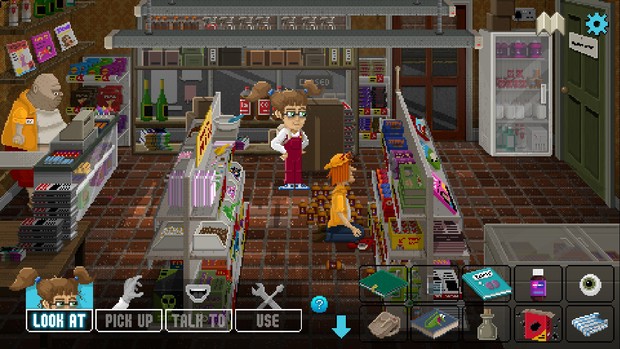Lucy Dreaming review – Don't sleep on this hilarious point-and-click pixel art adventure

- 0 Comments
Lucy, the titular heroine of Lucy Dreaming, is a smart, benevolently sarcastic thirteen-year-old girl. Equally adept at fixing bicycle flats or conducting high-voltage experiments as she is at brewing tea and baking love buns, Lucy is hard to put in a box – which might explain why she breaks the fourth wall so often. Now, I’ve seen many a gamer grouse about the immersion-breaking effects of such protagonist behavior, but Lucy is so darn likable as a lead that we are happy when she turns toward the screen and addresses us as a friend (or perhaps a sort of metaphysical Jiminy Cricket) who is joining her adventure.
And what an adventure it is! You see, as good-natured and gung-ho as she is, Lucy is preoccupied with a problem that has been plaguing her for years, which is, quite literally, rather nightmarish. You see, every time Lucy falls asleep, she finds herself falling, falling, falling, through the air at twenty miles per hour, until the moment she hits the ground and wakes up. She’s tried everything to ameliorate these nightmares: soothing lights, meditation, warm milk. Nothing helps, and so Lucy resolves to abandon her dream avoidance tactics and instead restore order to her sleep time subconscious by learning to control them.
Lucy Dreaming is a third-person point-and-click adventure game, very much in the vein of middle-era LucasArts titles. This is true from both a tonal and aesthetic perspective. Lucy herself could be the slightly less psychotic and slightly more self-aware cousin of Day of the Tentacle’s Laverne, and the graphical style in which both girls are rendered is similar enough that you’d believe they shared a pixelated bloodline. Graphically, the game could easily swash buckles with Monkey Island 2. Pixel art is contemporarily regarded as a retro affectation, but I believe that many recent adventure titles, Lucy Dreaming among them, prove that pixels are not only a throwback medium, they are also often the optimal medium of expression for their respective games.
Speaking of retro affectations, the music deserves special mention as well. In an exquisite show of love and audiophiliacness for 90s PC gaming, the game includes an option for on-the-fly swapping between AdLib and Roland MT-32 soundtracks. These are compositionally identical, but switching back and forth helps keep the game sounding fresh. It’s also a small marvel just how much of a different experience players of the nascent sound card age had when playing the same game.

As with many games that wear LucasArts influences on their sleeves, Lucy Dreaming is loaded with homages to the genre’s golden age. To the credit of Tall Story Games (aka Tom Hardwidge), however, these homages never go overboard, and never come across as an attempt to prove some old-school bona fides. The humor stands on its own, even when referencing what might be described, in 2022, as exhausted subject matter. Indeed, there is such a sense of amiable whimsy percolating through every crevice of Lucy Dreaming that I found it hard to be anything but utterly charmed by its myriad idiosyncrasies. There are, for example, hundreds of hotspots that are completely superfluous to progress, and you can attempt to look at, pick up, talk to, or use each one.
In addition to all of these ‘useless’ interactable objects littered throughout most screens, the pockets of Lucy’s adorable red overalls often prove to be even deeper than those of Guybrush Threepwood’s trousers, and more capacious than the ones in Ben Throttle’s leather jacket. That is to say, there’s usually lots of stuff in your inventory. In other games, this abundance of objects to click on and ways to click on them or combine them might be an irritating impediment, but Lucy’s lovable personality combined with the often laugh-out-loud cleverness of the script makes all this purely recreational clicking a joy. The fact that Lucy will find an excuse to automatically discard inventory items after they have done their duty helps alleviate potential try-everything-on-everything frustrations.
Not that it would likely come to that, anyway. Most of the puzzles in Lucy Dreaming are, within the context of the game’s admittedly kooky world and Lucy’s often … creative resourcefulness, quite logical and well-clued. There is a tendency in modern adventure game puzzle design to cater to the lowest common denominator of solving prowess. Many an adult-themed game will feature puzzles that wouldn’t be out of place on an elementary school progress test, or in a Pajama Sam game. While there is a place for such story-centric games in the market, I don’t believe that an immersive narrative and smart puzzle design need be mutually exclusive. Perhaps it is a challenging tightrope to walk, but Tall Story Games has just about nailed it with the puzzle design of Lucy Dreaming.

While some of the solutions are frustratingly too-well signposted (at one point Lucy tells us exactly where to lay a trap, rather than letting us deduce the location ourselves), I was also pleasantly surprised by how often I found myself temporarily stuck, backtracking, scrutinizing, and racking my mind for possible solutions. The difficulty escalates smoothly from chapter to chapter, as the locations on your map, the cast of characters you meet, and the depth of your inventory expand. It’s the kind of game you’ll put away, and then think about what to do next as you go about your day.
Many of the clues are found in the conversations you’ll have with the occupants of Lucy’s little hometown of Figgington. These characters, and the locations you can visit in the town itself, are deserving of special mention. There is the titmouse-hating photographer you encounter betwixt the town church and fairgrounds. Said church is ministered by a priest with a weakness for bosoms and jam, while on the opposite side of town you’ll discover a lovelorn Satanic librarian. If the products of her literary dark satanic mill can’t help you find the knowledge you seek, then a visit to Esme, the officious and gossipy docent of Fig Hall, just might. Each of Figgington’s citizens is a unique caricature, and as much fun to interact with as almost any of the classic NPCs of the genre. Indeed, there are many scenes in Lucy Dreaming that might just approach the iconic memorability of the untouchable genre classics.
The quality of this frankly certifiable cast of characters augment what is already an incredibly strong and well-structured narrative. In her quest to wrest control of her subconscious, Lucy will frequently have to travel back and forth between her dreamtime worlds and her wake-time one. To access these dreams, guided by her dad’s pop psychology book, Lucy must create a dream box and fill it with a variety of items of inspiration and companionship. Doing so will allow her to access the dreamworlds where she will find the equipment needed to conquer her nightmare.
Different dream box combinations will yield different situations in the dreamworld, which can be further affected by making small changes in Lucy’s bedroom and inventory. Dropping a joke book in the box, for example, will take Lucy to a bizarro comedy club. Throw in one of her toys, and its imagination-supercharged persona will join you there. Replacing the joke book with, say, a bread-baking one, will open up an entirely new area to explore. Part of what makes the game so enjoyable is the way it frequently takes you to new places – which are never quite what you expect them to be – thus adding a continual sense of progress, discovery, and adventure to the entire experience.
This waking/sleeping dichotomy spins a multitude of plot threads, all of which you will need to revisit in order to solve some of the game’s most challenging puzzles. As the endgame rapidly approaches, these threads are expertly woven into an extremely satisfyingly Hitchcockian conclusion. I've always thought that adventure games have their work cut out for them creating satisfying climaxes. Unlike in the action-oriented game genres, there is never going to be a great big insanely challenging last level and boss battle, and the subsequent relief of beating that boss and sitting down to watch the ending. In an adventure game, you add one last click to the thousands that preceded it, and you’re done. There’s precious little that any classic point-and-click game can do to completely erase this disadvantage, but Lucy Dreaming does such a good job setting up its climax that the aforementioned last click becomes quite satisfying and meaningful.
All gushing aside, there are a few flaws to Lucy Dreaming, although perhaps they’d be more accurately described as quibbles. I suspect that one or two jokes might be too UK-centric for non-UK-based players. A couple of characters are disappointingly underused. Lucy’s mad scientist brother, for instance, is the focal point of one puzzle before becoming a nigh-nonentity for the rest of the game. It’s a shame, because most of the denizens of Lucy’s world are entertaining enough that spending a little more time with them would be nice. Another minor issue is that all puzzle-relevant choices remain open in conversation menus after being clicked, but most plot-related dialogue can only be accessed once before disappearing. This makes it too easy to solve some puzzles, while at the same time making it frustrating if you want to revisit a certain plot point to refresh your memory.
These nitpicks aside, what Tom Hardwidge and Tall Story Games have accomplished with their debut effort is absolutely prodigious. The past 25 years have accumulated a veritable heap of adventure games that reference, recall, ape, or worship (in varying combinations and degrees) the 1990s LucasArts oeuvre. Some have been excellent, some have been tiresome, but precious few have been good enough that I would feel comfortable placing them on the same level as their classic inspirations. Lucy Dreaming is one of those precious few. From the moment I booted up the game, the good times rolled right up until the credits did. Lucy, as a protagonist, is on par with some of the best in the genre; helping her learn to take control of her dreams and solve Figgington’s oldest mystery in the process was a pleasure, and I hope the developer sees fit to let us team up again sometime in the not-too-distant future.
Final Verdict
With its loveable cast of characters, just-right level of challenge, and compelling plot, Lucy Dreaming is a complete win for Tall Story Games and adventure game players alike. The puzzle difficulty ramps up beautifully, just as the plot becomes progressively more compelling until it reaches its incredibly satisfying payoff. I would encourage seeing this one through to the end, but I don’t think I have to: you’ll be hooked from the moment you press Play until the moment the credits roll.
Hot take
Lucy Dreaming is so good that if it had been presented as a lost Schafer/Gilbert/Grossman collaboration from ’95 that was excavated and polished off for a quarter-century-late release, I’d half-believe it.
Pros
- Lucy is an endearing protagonist
- Colorful cast of supporting characters will have you looking forward to meeting every one of Figgington’s residents
- Funny writing that pays homage to its inspirations but stands firmly on its own
- Challenging puzzles that follow a straight thread of twisted logic with a satisfying difficulty curve
- Quality voice acting
- A mystery and ending worthy of Alfred Hitchcock
Cons
- A few puzzle solutions are a bit too obviously signposted
- A couple of characters who you’d think would be more relevant to the plot seem underused
Michael played his own copy of Lucy Dreaming on PC.











0 Comments
Want to join the discussion? Leave a comment as guest, sign in or register.
Leave a comment